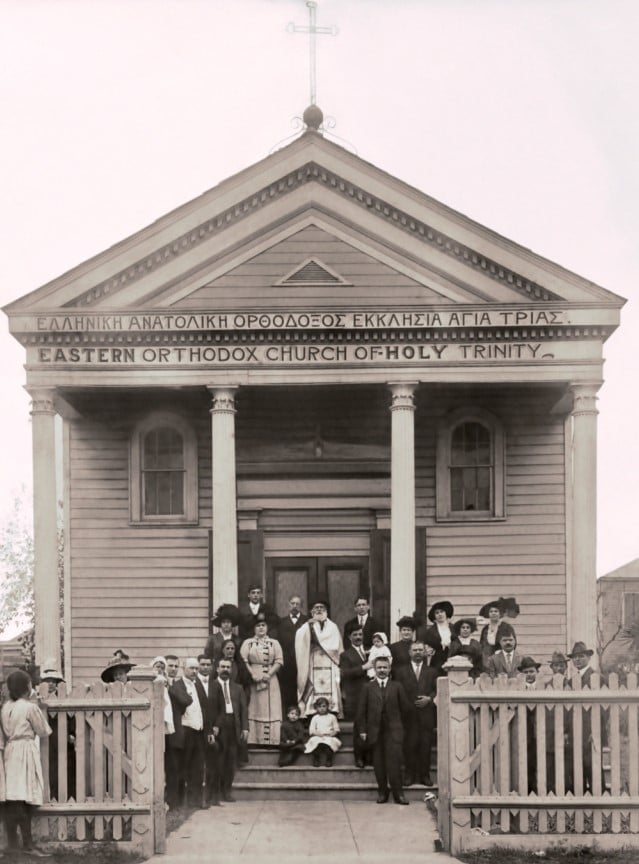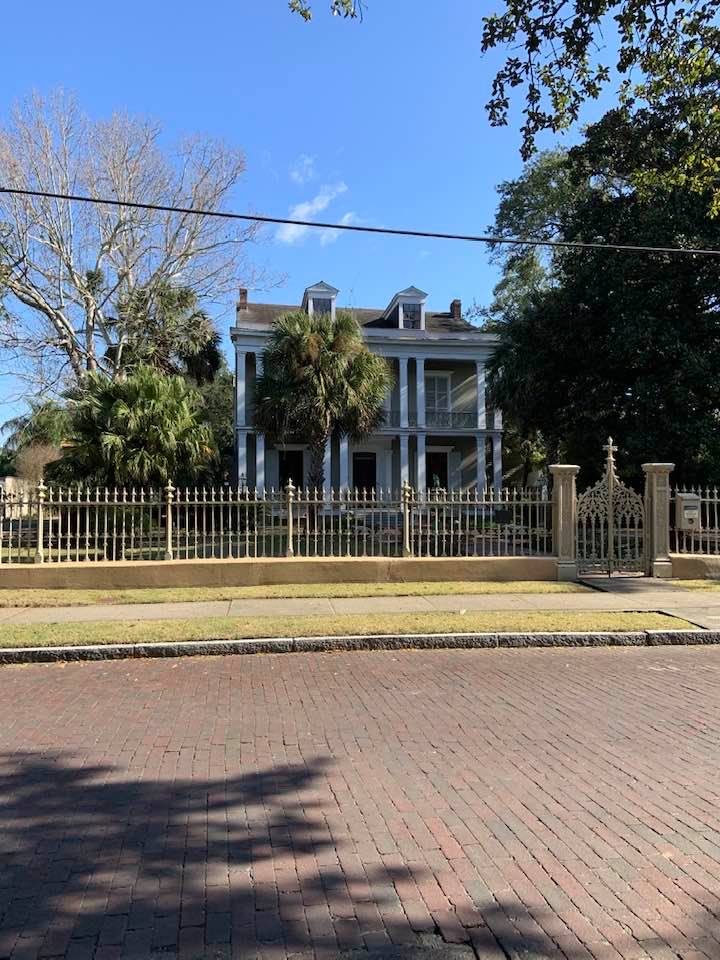
New Orleans is a delicious blend of the Old and New Worlds. It is hardly surprising that an enterprising, complex people like the Greeks would be attracted to such a place.
Situated near the mouth of the Mississippi River, which drains a vast portion of the North American continent, geography cast a central role for the city in the American drama.
It is often said that New Orleans is America’s most European city, yet it is also declaratively American, Southern, Latin, and African.It has a vast, dense, troubled, complicated history readily recalling the Old Continent. In a country where much is new, homogenized, and corporatized, here it is rich and sedimented, a center of commerce, cuisine, culture, and music.
The first Orthodox Church in the United States was established here in 1864 and built in 1866 by Greek merchants and other Orthodox New Orleans inhabitants. The church served an eclectic congregation of Greeks, Syrians, Serbians and other Slavic Orthodox city dwellers.

The First Greeks in New Orleans
I am driving to New Orleans’ “new” Greek Orthodox Church with Magdalene (Maggie) Spirros Maag. Maggie is the head of the Holy Trinity Archives Committee and my primary host for my recent visit. Rather than stopping at the church, she continued towards a bayou leading to Lake Ponchartrain.
Her goal was to start the story of Greeks in New Orleans from the first Greek inhabitants. The first confirmed New Orleans Greek, Miguel Dragon (Drague, Dragos, Draggonas), a “citizen of the Venetian islands” landed here in the late 1700s, where today there are remnants of an old fort. “Interesting how the Greek Orthodox Church made its way back to the site of the first Greek arrivals,” Maggie commented.
This Miguel Dragon had a daughter who married a Hydriot named Andrea Dimitry in 1799, who is counted as the third Greek in New Orleans. The Dimitry family subsequently became prominent in New Orleans commerce and government. Andrea Dimitry fought with US General Andrew Jackson against the British in the Battle of New Orleans. These were the first Greeks, and they arrived before New Orleans became part of the United States.The acquisitive, newly independent United States purchased New Orleans and the vast Louisiana Territory from Napoleonic France in 1803. The economy took off, particularly as the profitable but unspeakably cruel slave plantation economy spread throughout the lower South.
The Greek merchants in New Orleans
Island or kin-centered Greek shipping and merchant houses, which by the 1820s had emerged as powerful yet under-the-radar distribution players in the Mediterranean and Europe, set their sights on this Southern river port.
These merchants and seamen were not the immigrants of a century later, which was a mass migration of largely poor peasantry. They were, rather, part and parcel of that intrepid and cosmopolitan Greek merchant diaspora of the time, generally well-educated and funded. These people had built substantial enterprises in Odessa, Marseilles, Livorno, Venice, Vienna, Budapest, London, Alexandria, and Trieste.
New Orleans as a part of the worldwide Greek merchant web
The Greek merchants began arriving in substantial numbers in the early 1850s. The port was an entrepot of commerce, most notably the bumper crops of cotton grown in the vast plantations of Mississippi, Louisiana, and Alabama, but also the produce and production of the growing and rapidly industrializing American Midwest.Greek merchants had the contacts in Europe and the expertise in sea and river navigation (a substantial percentage of the pilots on the lower Danube River in Europe were Greek) to become wealthy and successful. Branches of the Ralli, Botassi, and Benachi families did just that.
In the period prior to the American Civil War (1861-1865), several hundred Greeks or other Orthodox lived in the city and like Greeks all over the Diaspora, they began discussing the establishment of a Church as a spiritual and community reference point.
Nicholas Benachi was one of the many Benachi scions established in key commercial ports. A native of Chios (under Ottoman rule until 1912), Nicholas Benachi first arrived in New Orleans in 1850 and quickly established himself in the cotton business. Like many merchants, he leveraged the opportunities and prestige of diplomatic representation, becoming Consul of Greece in 1854.
The first Orthodox Church in America
Together with a committee that included Constantine Kililis, a Greek from Asia Minor, and Michael Draskovich, a Serbian from Herzegovina, Benachi established the Holy Trinity Church in 1866, the first Orthodox Church in the United States.Initially, Holy Trinity was under the Synod of the Church of Greece, but by 1880, the community was under the Patriarchate of Constantinople, which is typical of Greek Orthodox Churches outside of Greece. While serving a primarily Greek congregation and using the Greek language in the liturgy, they pointedly also served liturgy in Old Church Slavonic and Arabic to accommodate Serbian, Russian, and Syrian members.
This multilingual ethos had been quite normative in the Merchant Diaspora; San Nicola Church in Trieste, one of the key Diaspora ports, served in both Greek and Serbian until the Serbians built Saint Spyridon Church around the corner from their former parish.
It also reflected, to a degree, a larger Romios (Byzantine) cultural identity shared by Orthodox Christians in the Ottoman Empire and its Diaspora. The Church Charter from 1901 states, in both its Greek and English versions, that the liturgy must be celebrated in Greek, Slavonic, and Arabic.
The original Holy Trinity Church was modest in size, a clapboard wooden edifice with declaratively Greek columns in front and a peaked roof adorned with a simple cross. Like so many Orthodox Churches in the Diaspora, Holy Trinity assimilated local ecclesiastical architectural norms. The church had a remarkable architectural similarity with southern US Churches of that era.This small church presided over an Orthodox community primarily Greek but consciously cosmopolitan even as nationalism was growing both in the Diasporas and in the mother countries fitfully emerging from Ottoman rule. This community was in constant contact with other Greek communities in Europe and the Mediterranean, connected by business, family, and regional ties, as well as the active thirst for opportunity.
Connection with Egypt
New Orleans cotton merchants channeled their expertise and capital into Egyptian cotton via the port of Alexandria and quickly Greeks, often from the same merchant houses in New Orleans, controlled a large portion of Egypt’s booming cotton trade. The first cotton gins were brought to Egypt by Greeks.
Though well established in the New Orleans business community by the 1860s, many Greeks left for other Diaspora locations due to the disruptions of the American Civil War (1861-1865), particularly Alexandria.
The community remained small and decidedly multiethnic, and the tenure of Bulgarian-born Father Misael, who came from the multiethnic city of Plovdiv (known in Greek as Philipoupolis), kept the community going despite the death of key benefactors, such as Benachi.In the Holy Trinity Archives, I found some of Father Misael’s books, written in a Bulgarian that had not yet been standardized in its own form of the Cyrillic alphabet, published either in Vienna or in the Mount Athos Monastery of Zografou. To hold such history in one’s hands, a book that predated Bulgarian independence, was a heady experience indeed.
Oh, yes, the books.
The archive saved by generations of congregants through several moves and the devastating Hurricane Katrina in 2005, and lovingly kept by Maggie and the Holy Trinity Archives Committee, included a trove of books, such as a Greek liturgical book published by San Giorgio de Greci publishing house in Venice, Italy. I was reading a book used by the oldest church in America, published by the oldest church in the Diaspora. I have had the pleasure of visiting this church in Venice.
Another was a grammar book written by a Greek philologist in Smyrna and published in Vienna in 1817. I also know the Greek Orthodox Church in Vienna, and I am pretty sure I have visited the building where this book was published. Then there were the merchant books, such as De Bow’s Commercial Review, published in 1847, listing the ships coming and going to various ports, with notations made by Nicholas Benachi.New Orleans’ deep Greek heritage
New Orleans’ deep Greek heritage is a legacy worn comfortably by today’s New Orleans Greeks. Most of the Greek community descend from that more recent mass immigration of the late 1800s and early 1900s, like most Greek Americans of today.
However, as a key seaport, there are plenty of sailors’ descendants among the community, including an active Chiot population which arrived post World War Two, readily recalling the enterprise of their fellow islanders, the Rallis and Benachis.
There is an elegance and gentility to the community that is perhaps a legacy of this long heritage. It reminds me a great deal of old Greek Diaspora communities in Europe.
They are heirs not only to the oldest Greek community but to one that was part of an organically linked Greek shipping and commercial diaspora, one built on skills, guts, regional and family loyalty, combined with a spirit of cosmopolitanism and mutual aid.These skills have made Greeks the world largest shipping nation and have figured prominently in the general success of Greeks abroad. We would do well to keep this history close at hand, for the lessons of the past both inspire and offer guidance to our present and future successes.






Comments
Post a Comment
Your opinion counts